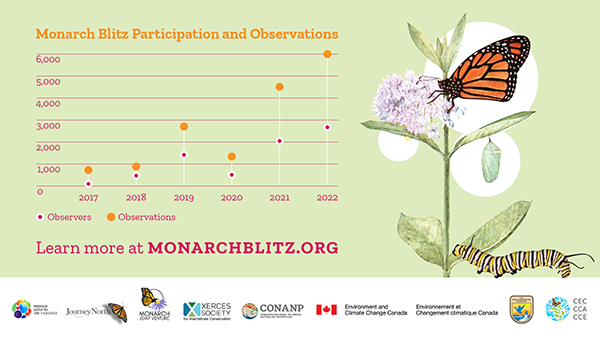Monarch Butterfly Conservation Supported by Record-Breaking North American Community Science Monitoring Blitz
The Commission for Environmental Cooperation (CEC) is proud to celebrate and thank volunteers across North America who answered the call to support monarch conservation efforts between 29 July and 7 August 2022.
For the second year in a row, engagement in the International Monarch Monitoring Blitz received enthusiastic participation, surpassing the rates of previous years, with a new record of more than 2,600 participants from across 75 states, provinces, and territories in North America. This support resulted in nearly 6,000 observations. In the context of the recent listing of the North American migratory monarch butterfly by the International Union for the Conservation of Nature (IUCN) on its Red List of endangered species, this trinational effort in community science demonstrates the vital importance and value of continental collaboration.
“The International Monarch Monitoring Blitz results demonstrate community interest and engagement to support conservation efforts for the migratory monarch butterfly population. The increased participation reflects how communities across North America have intensified efforts to gather information that will contribute to conservation and the research concerning this now endangered species,” said Alessandro Dieni, Mission Monarch Project Manager at the Insectarium, Montreal Space for Life.
Since the early 1990s, researchers have been actively monitoring overwintering populations at the Monarch Butterfly Biosphere Reserve, and other locations in Mexico, as well as in sanctuaries along coastal California. Only recently have researchers been able to expand monitoring efforts to better understand summer breeding populations. The annual Monarch Blitz helps support these efforts and would not be possible without countless volunteers active in community science programs across North America.
“At Monarch Joint Venture, we often receive inquiries from the public, wondering how monarchs are doing throughout the breeding season. We’re delighted to be partners in this trinational effort to better document range-wide breeding activity of this iconic species,” said Wendy Caldwell, Executive Director of Monarch Joint Venture.
Understanding monarch breeding habitat is key for effectively prioritizing and directing conservation action across the continent. Furthering this knowledge also makes possible the analysis of trends and factors that can lead to fluctuations in summer breeding populations.
To facilitate monarch butterfly migration research, Blitz data collected by volunteers have been published in the Trinational Monarch Knowledge Network repository and are available to anyone to consult and download.
For more information on this year’s results, visit monarchblitz.org or follow the #MonarchBlitz on social media. Learn more about the participating programs, below:
- Mission Monarch (Canada)
- Monarch Larva Monitoring Project (United States)
- Western Monarch and Milkweed Mapper (Western United States)
- Naturalista (Mexico)
- Journey North (North America)

About the CEC
The Commission for Environmental Cooperation (CEC) was established in 1994 by the governments of Canada, Mexico and the United States through the North American Agreement on Environmental Cooperation, a parallel environmental agreement to NAFTA. As of 2020, the CEC is recognized and maintained by the Environmental Cooperation Agreement, in parallel with the new Free Trade Agreement of North America. The CEC brings together a wide range of stakeholders, including the general public, Indigenous people, youth, nongovernmental organizations, academia, and the business sector, to seek solutions to protect North America’s shared environment while supporting sustainable development for the benefit of present and future generations
The CEC is governed and funded equally by the Government of Canada through Environment and Climate Change Canada, the Government of the United States of Mexico through the Secretaría de Medio Ambiente y Recursos Naturales, and the Government of the United States of America through the Environmental Protection Agency.
